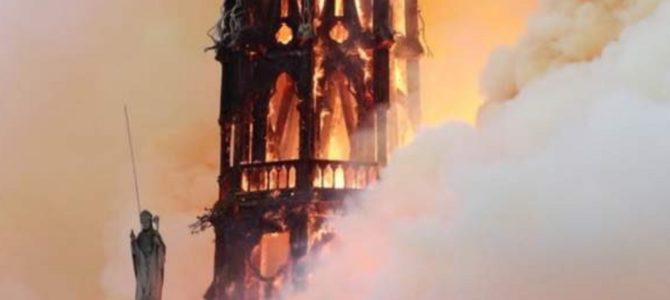
The 20th century Swiss-French architect Le Corbusier’s most famous aphorism, “Une maison est une machine-à-habiter,” is usually translated as, “A house is a machine for living in.” When it functions properly, a house can shelter us from storms, keep wild animals at bay, and give us a place to store our stuff. It may be more or less comfortable, depending on our circumstances, but the purpose of the house-as-machine is to help us survive. Anything else that a house may be is secondary to that primary function.
The primary function of a church, on the other hand, is something entirely different. Its purpose is not to ensure basic temporal survival, a purpose that could be met adequately, albeit unevenly, by a wide variety of structures. Rather, a church (small “c”) functions as a place to prepare for eternal life those who use it, through the ministry of the Church (big “C”) founded by Jesus Christ. In fact, to paraphrase Le Corbusier in a way that he would find absolutely appalling—which, quite frankly, pleases me no end—we can state that “A church is a machine for living.”
The Cathedral of Notre-Dame de Paris was just one such machine among thousands, albeit an exceptionally beautiful and highly revered one. Over the centuries, at least four or five previous churches have stood on the same spot where the current church now smolders in ruins.
Those who come to learn more about this structure’s long and tortured past will quickly realize that even this most venerable of buildings has been subject to a catalogue of endless, woeful human stupidities, from acts of iconoclasm and desecration, to awkward interventions and bad restoration. Monday’s conflagration was but the latest indignity to have been suffered by a building that had already suffered a great deal from unfortunate tinkering about.
While initial reporting on the fire was difficult to watch for a number of reasons, those who stayed with the coverage of Monday’s events saw that, as the fire retreated, hopeful reports began to come out. Broadcast and social media allowed people to share stories about and images of objects that had been saved: holy relics, works of art, historic documents, and so on. Later updates showed that some important parts of the old building even appear, rather miraculously, to have survived.
But long before this good news emerged, there was also a very different, and ultimately far more important, form of Good News on offer last night. It took them awhile to realize it, but gradually news commentators noticed that hundreds of Parisian Catholics, many of them young people, were kneeling together on the streets around the burning cathedral for hours, and continued to do so well into the wee hours of the next morning.
https://twitter.com/Christo99520687/status/1117990833322487809
Ave Maria pic.twitter.com/lb6Y5XV05a
— Ignacio Gil (@Inaki_Gil) April 15, 2019
WATCH: Viral video shows Parisians kneeling, singing "Ave Maria" outside burning Notre Dame Cathedral https://t.co/p6aY0UX2pp pic.twitter.com/nUjIyJNnv5
— The Hill (@thehill) April 15, 2019
Like the ancient Romans commenting on the way the early Christians went to their deaths in the Colosseum, the secular media had no idea how to process the sight of people praying the rosary and singing hymns to the Mother of God, even as the most famous building in the world dedicated to her was being reduced to ashes.
It reminded me of St. Paul’s explanation of why the rest of the world finds Christianity so incomprehensible:
The message of the cross is foolishness to those who are perishing, but to us who are being saved it is the power of God. For it is written: ‘I will destroy the wisdom of the wise, and the learning of the learned I will set aside.’
Where is the wise one? Where is the scribe? Where is the debater of this age? Has not God made the wisdom of the world foolish? For since in the wisdom of God the world did not come to know God through wisdom, it was the will of God through the foolishness of the proclamation to save those who have faith.
For Jews demand signs and Greeks look for wisdom, but we proclaim Christ crucified, a stumbling block to Jews and foolishness to Gentiles, but to those who are called, Jews and Greeks alike, Christ the power of God and the wisdom of God. For the foolishness of God is wiser than human wisdom, and the weakness of God is stronger than human strength. (1 Corinthians 1:18-25)
Whatever secondary purpose the old church may have served in the eyes of the secular world—artistic monument, selfie backdrop, architectural masterpiece, film location, historical site—it nevertheless managed to fulfill its most important, sacred, and primary purpose right up to the end. For even as the old church was being destroyed, it managed to bring together those who seek eternal life through Him who promised, “I shall rise again.”
May their witness to the truth of that declaration inspire all believers, both during this Holy Week, and for the future.









